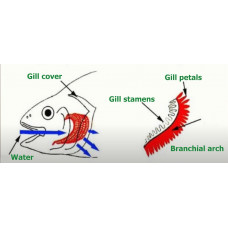Gills are the respiratory organs of fish; they are gill lobes on the gill arches with a well-developed network of blood cannillaries. In hagfish and lampreys - gill sacs on the inner walls of which are gill lobes supplied with blood vessels.
The gills of fish are located on the gill arches in the oropharyngeal cavity and are covered from the outside with gill covers.
In water, the dissolved oxygen content reaches 11 cm3 per liter. Unlike many aquatic invertebrates (such as sponges, mosses, leeches), which absorb oxygen through the entire surface of their body, more complex organisms have special organs for this at the border with the environment, called gills. Breathing in sea urchins and starfish occurs with the help of very primitive gills, called papules, or skin gills. These are numerous thin—walled outgrowths in the spaces between skeletal plates on the surface of the body containing diverticula - tubular organs of water circulation. In crustaceans, mollusks and some insects, the gills are tufted or flat outgrowths on the surface of the body in which blood circulates. The blood of many of these animals contains respiratory pigments — blue hemocyanin and red hemoglobin, which bind a large amount of oxygen.
The internal gills of vertebrates are located in the walls of the pharynx and are rows of gill petals that are located on the gill arches. The pharynx of fish and amphibian larvae is riddled with gill slits. The water entering the mouth passes through these cracks, supplying the body with oxygen. Some fish use gills to secrete electrolytes. In some amphibians, the gills are also located inside the oral cavity. In the early stages of development, tadpoles, larvae of some fish (for example, lungfish) and larvae of tailed amphibians (as well as some adult neotenic forms) have external gills in the form of branching thin outgrowths. Most species have a countercurrent system to enhance the diffusion of substances through the gills, where blood and water flow in opposite directions. The large surface of the gills creates problems for fish, which regulate the osmolarity of blood plasma. Because seawater is less diluted than blood, marine fish lose a lot of water through their gills. To restore balance, they drink a large amount of sea water and bring out salt.
The gills of mollusks — Ctenidia — are two-pinnate outgrowths in the mantle cavity. In plate-gill mollusks, they are modified into mesh plates. In gastropods, due to the asymmetry of their body, the gill on the right often disappears; in many of them, due to the transition from an aquatic lifestyle to a terrestrial one, the gills are gradually reduced, and part of the mantle cavity is transformed into an air breathing organ. The gills of crustaceans develop as appendages of limbs; most of the lower crustaceans (copepods, barnacles) have no gills. In most higher crustaceans, they are represented by two-feathered branched or lamellar appendages of the pectoral legs. Due to the release of some crustaceans on land (tropical species of crabs and hermit crabs), their gills were gradually reduced and the gill cavity turned into a lung, adapted for air breathing.
All primordial chordate animals have gill openings in the pharynx, or slits that open either directly outward or into a special near-gill cavity associated with the external environment. In intestinal breathers, tunicates and in craneless (lancet), gas exchange is carried out when water passes through the gill slits, in the partitions between which blood vessels pass. The roundworms have from 6 to 14 pairs of gill sacs bearing gill lobes of endodermal origin. The undifferentiated gill arches are located outside of the gill sacs. In fish, the gill petals are formed from the ectoderm. The half-gills of two adjacent gill slits, located in front and behind on the gill septum, form an integral gill. There are cartilaginous or bony segmented gill arches on the inner pharyngeal edge of the gill septa. The outer edges of the gill partitions only in sharks cover each gill slit in the form of skin folds. In sturgeon fish, the gill septa are shorter than in sharks, in bony fish they almost completely disappear; the gill petals are attached directly to the gill arch, hanging freely into the gill cavity, covered from the outside with a movable gill lid, and from the inside protected by the outgrowths of the gill arches — gill stamens. The larvae of polypterus, lungfish and some bony fish (for example, loaches) have external gills in the form of feathery outgrowths on the gill arches.
Gills
Tags: gills

